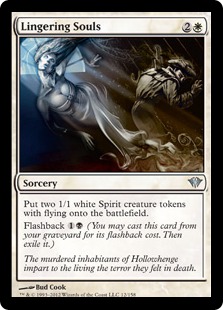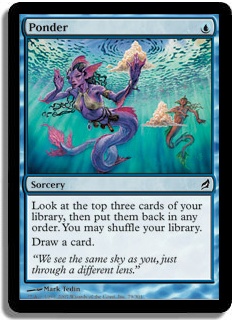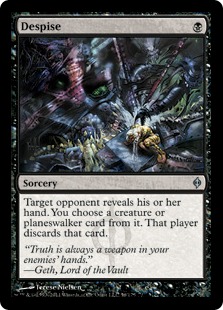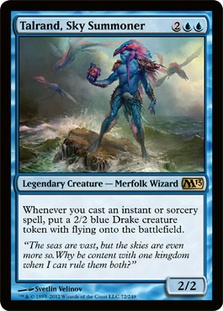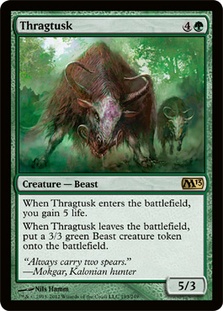Sorry about the amount of time between the last article and this one. I had to scrap my Limited one midway through. I’m hoping for a Limited redemption from Return to Ravnica because Avacyn Restored was terrible for Limited.
I don’t mean to start this jovial article off with a rant, but I’ll keep it brief.
Avacyn Restored Limited
Avacyn Restored (AVR) is a flavorful set for those who love Angels and miracles, but the casual player in me died long ago, so we’ll look at the set from the eyes of a tournament grinder.
While every format has rares that must be answered, this format has more than average, and some are literally unanswerable. Cards like Bonfire of the Damned, Entreat the Angels, Moonsilver Spear, Demonic Rising, Homicidal Seclusion (at times), and many others limit your ability to interact. Even though all Limited formats have bombs, I feel that after drafting close to 50 times online it is much worse in AVR. I have never played so many matches in any other format devoid of combat and spell interaction due to the rares. Luckily, we usually can fall back on a wonderful set of commons and uncommons or new mechanics…not in this case, sadly.
The speed of the format came to a screeching halt in AVR. On countless occasions I’d drafted an insane R/W or G/R "aggro" deck, only to nearly concede from a turn 4 Seraph of Dawn. Who would have thought that a common 2/4 flyer for four could be unbeatable? If you aren’t holding the answer immediately, you will understand exactly what I mean. We’ve all run into a tough Giant Spider in core set Limited, but the lifelink ensures that defense is not always the name of the game. It’s totally viable to have Seraph be your first play of the game on turn 4.
There are many other situations in AVR that make players like Owen Turtenwald say things like:
"We should force prisoners in Abu Grab to play AVR sealed."
He isn’t the only player to come out publicly about not liking AVR Limited; we’re all hoping for a Limited redemption come Return to Ravnica. M13 has been a pleasant experience so far, but the main reason I’m waiting for Ravnica is because that is where true Limited flourishes. We all crave an excellent Limited format where a series of great mechanics fit together and form a cohesive whole using an entire expansion.
Anyway, aside from that, the last few months of Magic have been all grins. We are going to start off with a brief description of the decks that helped me make Top 8 of both of the last two SCG Invitationals and discuss card choices. After that, I am going to give you a little taste of innovation with two new M13 decklists that I will be trying at the upcoming SCG Open Series in Las Vegas and in Washington D.C. Let’s get started!
SCG Invitationals in Baltimore and Indianapolis – Standard
Creatures (2)
Planeswalkers (8)
Lands (26)
Spells (24)

To Walker or Not To Walker
As you all know, when I set my mind to playing a deck I stick to my guns for the long haul as long as I keep winning. After the first Top 8 with Esper Walkers, there was a lot of talk about the general weakness of the deck and specifically the planeswalkers.
At the top of the list was Sorin, Lord of Innistrad. His inability to produce creatures to block flyers is his one obvious flaw, but luckily in the game of Magic not all decks produce flyers. Against the green menace, which produces a lot of ground pounders and gets through with Sword of War and Peace, Sorin really shines. Sorin is also very powerful against Blade Splicer variants with only Restoration Angel to worry about, and control decks always fear any planeswalker that sticks—whether it is Sorin, Tamiyo, or Liliana.
With that said, it is unfair to refer to Sorin as "garbage." Anyone who follows my articles or has seen me do battle knows that when the general consensus of a card is negative, it drives me to make that card even more effective in the metagame. Sadly the metagame on Magic Online and in real life has shifted into a Pike/Delver majority, and that weakens Sorin a lot. Not only does that hurt Sorin’s effectiveness, but it also hurts planeswalkers as a whole.
Sun Titan is much more effective against blue decks with the addition of Cavern of Souls. Planeswalkers won by jamming cards onto the battlefield, but with Sun Titan / Grave Titan, you remove Mana Leak from the equation, and Vapor Snag doesn’t derail Titans like it does Consecrated Sphinx. Sphinx has more game-breaking consequences if not dealt with, but more often Sun Titan can bring back Phantasmal Image to kill an opposing Geist of Saint Traft or a Ratchet Bomb or a Nihil Spellbomb, which is just too good.
You would think the Titan strategy would be better against the green decks, but I lost more games to a Sword of War and Peace or lack of Wrath effects—problems that are much easier for the Walker Control list. It isn’t cut and dry. However, for the time being I would stick with Sun Titans until Delver loses some steam or until rotation.
In this last month or so, I have been battling with this more Solar Flare-ish deck online and in small local tournaments with some success. I played in the Magic Online PTQ with this build and beat Delver four times, but I lost to wacky control decks three times before I decided to discontinue playing.
It definitely brings up the same old dilemma…do we play the deck that crushes the control mirror and green decks (Esper Walkers) or do we choose the deck that defeats the "best" deck on a regular basis (Solar Flare with some planeswalkers)? Solar Flare has great numbers against Delver as I mentioned, but its track record against Pod and Sword of War and Peace is much worse than Esper Walkers. In this short period before rotation, I will be trying all of the above and more. Here is the deck that I have been playing for the last month.
Creatures (5)
Planeswalkers (3)
Lands (25)
Spells (27)

Card Focus #1—Lingering Souls
Some key differences between my Esper Control deck here and the Solar Flare decks are from Magic Online testing and about 100 matches. The fourth Lingering Souls was great in the Walkers list when protecting your interests, but in Esper Control I found that it was just too many. Decks are getting more resilient to Lingering Souls, mainly due to the growing popularity of Blade Splicer in all forms of Delver and U/W Midrange. Lingering Souls is fantastic against most things, but drawing them in multiples against some decks has directly resulted in a few losses personally.
The biggest appeal for the token production is the fact that you can pitch it with Forbidden Alchemy and generate free advantage. That happens much more often with a full set of the Souls, but I have found that three is the perfect amount for the current metagame to avoid getting overwhelmed with them being in hand. The two Phantasmal Image serve a similar purpose, which gives you five ways to stall early in the game.
Copying a Strangleroot Geist and trading then copying their Birds of Paradise does the job even better in certain scenarios. That combined with the ability to instantly kill a Geist of Saint Traft instead of the Vapor Snag dance Lingering Souls puts you in is also a nice relief. Phantasmal Image can be the greatest card in your deck at times or dead as a doornail, which is why we don’t want to overwhelm the list with a narrow solution. You will want to board in the fourth Lingering Souls against Delver decks using Geist of Saint Traft, but in most other matchups I would leave the number at three.
Card Focus #2—Ponder
I have always been an opponent to control decks playing the one-mana cantrips that produce no real card advantage, but I have given in lately. The biggest reason that I concede to playing cards like Ponder and/or Preordain is because the lack of good blue card draw that has plagued us for years. Even Wall of Omens / Spreading Seas was enough to cantrip me to a third mana for the next decent card draw spell of its time (Jace Beleren then). But we can’t have everything we want, control mages, so let’s cast Ponder and reorganize those cards so we make our land drops to the promised land of Forbidden Alchemy.
In this list, Ponder is just for that early on. Most of the time these cantrips shine later in the game, but the purpose of it here is to guarantee that we can play our big, powerful spells without and delay, and it has worked for some extent. If you notice the differences between the lists, you will see the removal of Think Twice. I was wrong to play Think Twice this entire time, and it was only decent with Liliana of the Veil. I think Ponder was a better fit and more Forbidden Alchemy were needed in all the tournaments that I played Esper Walkers in.
Think Twice is simply too slow with not enough advantage to make a huge impact on the game, and its purpose was the same as Ponder: get to that land as fast as possible. You will not see me play Think Twice during the last few months prior to rotation and probably not even post-rotation due to the fact that aggressive decks are getting faster and faster. So if you decide to run Planeswalkers or Sun Titans, make sure to drop Think Twice for Ponder.
Card Focus #3—Despise
This card is only a topic for discussion due to the shear awesomeness of it. Despise has been almost as good in this current format as Inquisition of Kozilek, and I will explain why. Delver is currently running more creatures than ever. With the inclusion of four Restoration Angel and a planeswalker package of Gideon and/or Tamiyo either in the main or in the board, Despise will hit. If Despise does miss later in the game, it gives you the full information needed to jam Curse of Death’s Hold or other vital spells once the coast is clear. Hand information for a control deck is very important and gives you a battle plan for success. But like I said…Despise rarely misses nowadays.
The green decks all cringe at a turn 1 Despise with some of the keeps that they have. I don’t know how many times I’ve open with a Despise and seen Bird, Strangleroot Geist, Wolfir Silverheart, and land. That one Despise gave me a clear road to victory and makes it easy to plan each counter to your opponent’s plays. It not only punishes weak opening hands; it also makes opponents play differently. Gerry Thompson in the last SCG Invitational chose to draw first game 3 due to my inclusion of Despise in Esper Walkers. He felt that he needed to attrition me out of the game and hands that contained one Geist of Saint Traft and some cantrips would be ruined on the play. His logic made sense, but having a control deck go first will not make me complain in any scenario. Â
When Luis Scott-Vargas won a Super IQ with my deck, I had Despise in the sideboard and he said he never wanted to board it in, but that was a different time. Now, at any point in the game you are probably going to snag a Restoration Angel, Huntmaster of Fells, or a Karn before it lands and ruins your life. The hand information is the added bonus that allows control mages to play optimally. I only board out Despise against Reanimator decks or decks that are super creature/planeswalker light. Keep it in for most matchups.
The rest of the cards are pretty standard and do not need much explaining. The Grave Titan was a Wurmcoil Engine, and that switch was an easy call. Grave Titan has that steal game ability and resilience against removal that makes him a key asset to the deck. The Griselbrand in the sideboard provides a control-slaying card when resolved, but it can easily go back to a Volition Reins if you aren’t feeling that adventurous. The only other change I might make depending on the metagame in your area would be adding a third Memoricide and dropping a Celestial Purge. There is a decent sized Zombie population online so I made that particular switch, but I loved having three Memoricide against control mirrors, Frites and ramp decks, so that is another close call.
Well, enough of the old Standard decks I have been battling with; it’s time for some of my wacky concoctions that start to creep up with an upcoming format change. This first list is something that you normally wouldn’t catch me playing in any situation, but I can tell when a card is powerful regardless of my personal bias. Sadly, Brad Nelson ruined it for me when he posted a video of him battling Gerry with his version of the deck I thought I was so clever in producing. It turns out that a ton of people know how powerful Talrand is, so expect to see people trying him out in full force. Here is my take on the deck.
Creatures (12)
Lands (21)
Spells (27)
- 4 Mana Leak
- 4 Ponder
- 1 Negate
- 4 Gitaxian Probe
- 4 Vapor Snag
- 3 Gut Shot
- 3 Runechanter's Pike
- 4 Thought Scour
Sideboard

Talrand has a lot going for him when we think about the power level of a card. Although he does not have evasion by himself, his army of Drakes have more power than their Spirit predecessors. The ability to drop him and let go multiple free spells you held for a turn or two to create an instant army without wasting more than one card is absurdly powerful.
He suffers the same problem Emeria Angel and other powerful four-drops had: he can just be countered or removed. That was before Cavern of Souls, which can guarantee his survival on to the battlefield. Once he is there, you have sideboarded Spellskites or just smart planning to ensure you gain a ton of advantage before he leaves play again. He reminds me of Hero of Bladehold in the sense that if you untap with him, you will nearly combo out with the amount of cantripping that is present in the deck. Talrand provides advantage with just two instant or sorceries cast because six power created for the cost is well worth it.
His disadvantages are clearly visible. He is a legend, so no shenanigans will take place with infinite flyers going crazy. He presents the same problem that a Geist of Saint Traft has on a rare basis: awkward opening hands. You have to play four of him to guarantee him landing in play turn 4 for you and also in case of a well-timed Despise or removal spell. Another disadvantage is he is only a 2/2, which results in nearly instant death from combat or a burn spell. Those disadvantages, however, don’t outweigh the power that the Merfolk Wizard provides a deck built around his strengths.
So what did it take for a guy like me to sleeve up a mono-blue deck with Delvers, no less? I have a weakness for Emeria Angel-like cards, and if it wasn’t for that particular Angel I would never had chained a few Pro Tours together off of the one PTQ. Flyers, as we all know by now, are just too good in an aggressive world, and cards that cantrip and provide real board advantage at the same time can create a nightmare for any opponent. I will probably play this deck at the SCG Open Series: Las Vegas coming up in a week in a half, so root for me as I cast my first Delver of Secrets in a Constructed format. But don’t worry readers, I am no traitor…this is just an experiment to test out Talrand’s true power, then it is back to expensive sorceries for me.
This leads me to my next wacky Standard deck I came up with after the M13 spoilers were fully released. This deck is untested and completely based on theory, but that is the basis on how my decks are founded. Blue control is bread and butter for players like me, but once in a while I like to craft a control deck that dodges the blue persuasion. These random time periods only take place when a format exists that is void of powerful card draw and counter magic. With the exit of Mana Leak in a few months, I wanted to give a Doran-colored control deck a shot. Take a look!
Creatures (19)
- 4 Elvish Visionary
- 1 Borderland Ranger
- 2 Sun Titan
- 1 Elesh Norn, Grand Cenobite
- 4 Blade Splicer
- 4 Restoration Angel
- 3 Thragtusk
Planeswalkers (7)
Lands (25)
Spells (9)
Sideboard

This deck is a much bigger Hail Mary than the Wizards deck I talked about earlier. Its power focuses around creatures that have abilities when they enter play. The difference between this strategy and the Pod strategy is that this deck desires going to the late game. Doran Walkers can come out like an aggro deck with some starts, but the loaded removal package ensures that its midgame can beat most other decks’ midgames. The basis for the card choices answers the question, "Is it good against Delver?" which is mandatory for the last few months with the 3/2 flyer. Each creature has a powerful affect against all builds of Delver, whether it is a matching Blade Splicer / Restoration Angel or the powerful Lingering Souls that can clog up the board with ease.
Thragtusk is the card that gave me the motivation to play a green deck in some way. He is everything a control mage dreams about all in one creature. He provides an instant life boost, a threatening five power, and an ability if removed. He is everything and more, and I think he will be a very good card for quite some time. Another big advantage of Thragtusk is that Vapor Snag doesn’t scare him in the slightest. He will get in there for damage and put you ahead on the race, and that’s without a Restoration Angel to make it even sillier. Each creature is amazing against Delver, and that is where the planeswalkers come in to create balance.
Since we aren’t playing blue, there must be a way to produce card advantage, and Elvish Visionary doesn’t cut it alone. With the help of the powerful creatures, the planeswalkers can come into a relatively safe board state and immediately begin to assist you to victory. The biggest reasons for all the planeswalkers is the hurting that they put on green decks. As I said earlier, Sorin still is a great card against green and since you have all the creatures to compliment him, you will see lasting survivability of Sorin, Ajani, and Gideon. The Garruk Relentless and Ajani are added as bullets to hit control decks on your way to a championship. All planeswalkers are good against control decks, but these two planeswalkers are exceptionally good against them. I don’t know what I could be scarier than a card that gives a monster double strike that doesn’t go away after. The lingering presence of planeswalkers in this list and other lists make them that much more effective against any deck that isn’t killing you in the first half of the game.
When you look at the list, you will notice my control staples that come attached to any list that can cast them. Whether it is the one Karn Liberated or the Curse of Death’s Hold package, I am always prepared against the fringe control/rogue lists and the tier 1 balcony that Delver sits upon with green not too far away. And above all, I think that this deck is actually pretty fun to play. If I get crushed while playing Mono-Blue in Vegas, then expect me to give this deck a whirl in one tournament before I shove Islands back in with my planeswalkers. I think I would have rather played this for the first M13 tournament, but I don’t have access to all the cards at the moment, so it’s Talrand I go!
Last But Not Least…Legacy
I want to talk about Legacy a little in this article, but I am not an innovator to say the least in that format. Here is the list I played at the last SCG Invitational.
Creatures (8)
Planeswalkers (3)
Lands (22)
Spells (27)

I have played in a grand total of five Legacy tournaments since SCG stopped doing their Dual for Duals and switched to the Legacy Opens. My first tournament was at GP in Columbus where I went 0-2 drop with Charbelcher, and at that point I decided to dodge the format like the plague. It drove me to target and take down SCG Draft Opens, and that provided me with enough success to justify skipping the Legacy portion of all tournaments that I attended.
Once they announced the end of the Draft Opens, I realized it was time to get cracking at this ancient format, and man, was I pleasantly surprised. After back-to-back Top 8s at the SCG Invitationals, I have this confidence in a format that I never thought I would ever have. I also got 39th at GP Atlanta a few weeks ago with the same list, so I would suggest it to anyone. The reason I am going to keep my Legacy debrief short is because most of you guys know this deck as well or even better than I know it. I don’t need to explain why Jace, the Mind Sculptor and Stoneforge Mystic are powerful, but here are a few things I would love state for the public eye:
- Terminus was an amazing bullet that buried multiple Maverick players under a mountain of card advantage.
- Lingering Souls might not be very good against Griselbrand, but it is good against everything else, especially the mirror match and Delver decks. Don’t cut it.
- Cabal Therapy was great, and you should play at least one more.
- Sword of Feast and Famine stole a game against Elves, but besides that was ok at best. Leave it in the sideboard.
- Force of Will is still great in the deck, but board it out against non-combo decks to free up room for sideboard cards.
- The one of Vindicate and Wasteland saved me in the GP and the SCG Invitational. Having outs in your maindeck to problem cards is never a bad thing.
- Playing well with this deck will reward even the least experienced players around. This deck doesn’t have any unwinnable matchups, and the more used to the cards you get, the more you will understand where I’m coming from.
I’m not saying I am in love with Legacy now, but you all understand the same theory I have in Magic. Winning is fun. So as long as I keep winning in this format, the more I will support it. The best thing about Legacy besides the winning is the variety of decks that exist. It is a stagnant format in a sense because of no rotations and limited bannings. With that being said, you will play against some opponents who have this decked out, all Beta Legacy deck that 1% play and, you have to be ready. Or you will play someone like me who built this entire deck for about 1000 bucks and will never buy a new deck again. Since I’m not a big tournament report guy, if you are more interested in specific matchups then please hit me up on Twitter. I’d love to let you know.
Well, I hope you enjoyed the article. I had a lot to say in this one about the Walkers that you all know and love and a few of my crazy thoughts on the upcoming Standard format with M13. I will dedicate a large portion of my next article on which deck I will be sticking with in the upcoming months before rotation, and I will let you all know any updates that pop up. Thanks for reading guys, and I’ll see you all next time!
Shaheen
@shaheenmtg – Twitter
Soorani.mtg@gmail.com


